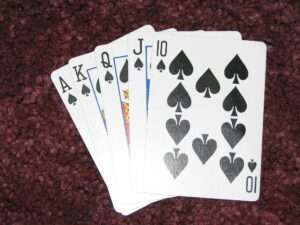
Counting cards in poker is a simple technique that a player can use to determine whether or not he should raise, call, or fold. It is not a foolproof technique, but can provide valuable insight into the hand. To do it correctly, players must follow a few basic rules.
Firstly, they must be able to count the number of cards in a specific suit. Once they have done this, they can then calculate the probability of each card winning. This is called card reading, and is a technique used to play games like blackjack and poker. In poker, players can calculate the pot equity, which is the percentage chance of winning the hand. If the cards in the deck are split into four suits, the probability of the player winning a certain suit is a little bit lower than if the cards are divided into two or three suits.
Similarly, in Texas Hold ’em, they can also figure out the odds of hitting a flush or a straight. For instance, if a player has nine outs, he has a 65% chance of drawing for a flush, but only a 20% chance of hitting a straight. The odds of an open-ended straight draw are a little higher. Using the “rule of four and two,” which works best on the flop, the odds of hitting an open-ended straight draw with 8 outs are a little over 68%.
Finally, they must be able to make a calculation in their heads to see how often they should bet based on the card reading. If a player has a good hand, he can bet more than his opponent, but if he has a poor hand, he should bet less.
The number one rule of card counting in Texas Hold ’em is to avoid double counting. This is because, as a player, you will only be able to see the last three cards of the opponents. Therefore, you will only be able to calculate the probabilities of a certain hand if you know exactly how many of each type of card are left in the hand.
To do the calculation correctly, you should look at the number of outs on the board and multiply that by four when you’re on the flop and by two when you’re on the river. There are two types of outs, sequential and non-sequential. Sequential cards are a better bet because they have the highest chance of being paired and forming a straight, whereas a non-sequential hand is not.
One thing to remember is that calculating the odds is not always practical, especially in a real game. Luckily, there are plenty of programs on the market to help you figure out how likely your hand is to win. You can use an online tool like PokerTracker to get a number of stats on the hand.
Card counting in Texas Hold ’em is not a guaranteed way to win, but it can be a great way to make your moves more intelligently. Knowing the odds of a hand and figuring out what to bet on will help you bet more efficiently, and increase your chances of winning.


